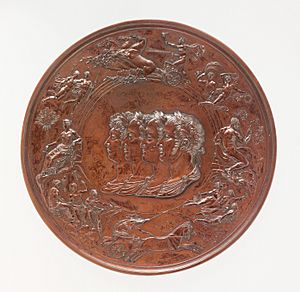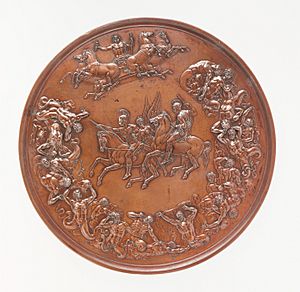Waterloo Medal (Pistrucci) facts for kids
| United Kingdom | |
| Obverse | |
|---|---|
 |
|
| Design | The four rulers of the nations triumphant at the Battle of Waterloo, surrounded by a mythological allegory evoking peace |
| Designer | Benedetto Pistrucci |
| Design date | 1849 |
| Reverse | |
 |
|
| Design | Equestrian figures of Wellington and Blücher surrounded by a design representing the defeat of the French |
| Designer | Benedetto Pistrucci |
| Design date | 1849 |
The Waterloo Medal is a special medal designed by an Italian artist named Benedetto Pistrucci. He worked on it for a very long time, from 1819 to 1849. The British government ordered this medal in 1819. It was meant to honor the generals and leaders who won the famous Battle of Waterloo in 1815.
However, the medals were never actually made and given out. By 1849, most of the people who were supposed to receive them had passed away. Also, relations between Britain and France had become much better. Today, new versions of the medal have been made for people who collect coins and medals.
Contents
How the Waterloo Medal Idea Started
After the Battle of Waterloo in 1815, the winning general, the Duke of Wellington, suggested a special medal. He thought bronze medals should go to British soldiers, silver to their officers, and gold to the leaders of the winning countries.
At first, a different artist, John Flaxman, was chosen to design the gold medal. But Benedetto Pistrucci, who was in charge of engraving the metal molds (called dies) at the Royal Mint, refused to copy someone else's work. He wanted to create his own design.

The Prince Regent (who later became George IV) and William Wellesley-Pole, the head of the Royal Mint, were very impressed by Pistrucci's ideas. So, Pistrucci got the important job of designing this grand medal. He was paid a large sum of money for his work.
What the Waterloo Medal Looks Like
The Waterloo Medal is very large, about 5.3 inches across. It has two main sides: the front (called the obverse) and the back (called the reverse).
The Front (Obverse) Design
The front of the medal shows the four main leaders of the winning countries. These are George, Prince Regent of Britain, Emperor Francis I of Austria, Tsar Alexander I of Russia, and King Frederick William III of Prussia. They are shown together, looking to the side.
Around them, Pistrucci added many symbolic figures. For example, Apollo, the god of the sun, is shown in his chariot, bringing back the day. Other figures like Zephyrus (who scatters flowers for peace) and Iris are also there. The chariot flies towards Castor and Pollux, who represent the Gemini constellation. They also stand for the victorious generals, Wellington and Blücher.
The goddess of justice, Themis, appears before the rulers. This reminds everyone that justice is more important than power. Below her are the Fates, showing that human destiny is guided by justice. Behind the rulers, a man with a club represents power. Below him are the Furies, showing that human actions are subject to power. At the very bottom, a figure representing night is fleeing.
The Back (Reverse) Design
The back of the medal features Wellington and Blücher on horseback. Victory is shown between them, guiding them into battle. These figures are in a Greek style, similar to Pistrucci's famous St George and the Dragon design for the British sovereign coin.
At the top of the reverse is Jupiter, the king of the gods. Around the edge of the medal are 19 figures of giants that Jupiter has defeated. These giants represent the defeated enemy, with one giant for each year of the long war.
Pistrucci originally planned to put words on the medal, like the names of the countries and the date of the battle. However, these words were not included in the final design. Modern versions of the medal, made in 2015, did add these words back.
Why the Medal Took So Long
The Waterloo Medal took a very long time to finish. By 1822, much of the work was done, but there were problems. King George IV did not like how Pistrucci had drawn him for other coins. He ordered a new design based on another artist's work. Pistrucci, again, refused to copy someone else's art.
This made the King very angry. Pistrucci was then told to stop working on coins and focus only on the Waterloo Medal. He worked very slowly, perhaps because he worried he would be fired once the medal was done. He wanted to keep his job at the Royal Mint.
Pistrucci also faced health problems, including issues with his eyesight, which slowed him down even more. Many different heads of the Royal Mint tried to get him to finish the medal over the years.
The Medal's Completion
In 1841, William Ewart Gladstone became the new head of the Royal Mint. He respected Pistrucci but would not give him new projects until the Waterloo Medal was finished. By 1844, the cost of Pistrucci's long work was a concern. Gladstone offered him a bonus of £400 to complete the medal.
Pistrucci moved to a new workshop and worked hard on the medal. He was slowed down by a fall in 1846, which kept him from working for a while. Finally, on January 1, 1849, Pistrucci delivered the completed metal molds (matrices) for the medal to the Royal Mint. He was paid £1,500.
The molds were very large and delicate. Officials at the Mint were afraid to harden them into dies, as they might get damaged. So, only a few copies were made using a special process called electrotyping. No actual medals were ever struck from the original molds.
Also, by 1849, relations between Britain and France had improved. Giving out medals that celebrated a victory over France seemed impolite. Most of the important people who were supposed to receive the medal had also passed away. Only the Duke of Wellington was still alive.
Pistrucci was very sad about the whole experience. He felt that his hard work had caused him many troubles.
How People See the Medal Today
Experts who study coins and medals (numismatists) greatly admire Pistrucci's Waterloo Medal. They call it one of the most amazing examples of medal-making art. Many say it shows Pistrucci's incredible talent. The original molds are still kept at the Royal Mint and are considered some of the finest medals ever made in Europe.
Pistrucci's original wax models for the medal are kept in a museum in Rome.
In recent years, the Royal Mint has made smaller versions of the Waterloo Medal for collectors. In 1990, they made bronze versions for the 175th anniversary of the battle. In 2015, for the 200th anniversary, they made silver versions that included the words Pistrucci had originally planned. Full-size silver versions were also made and given to the ambassadors of Austria, Russia, and Germany, and one was presented to Queen Elizabeth II. These large medals weigh about 4.5 pounds!

